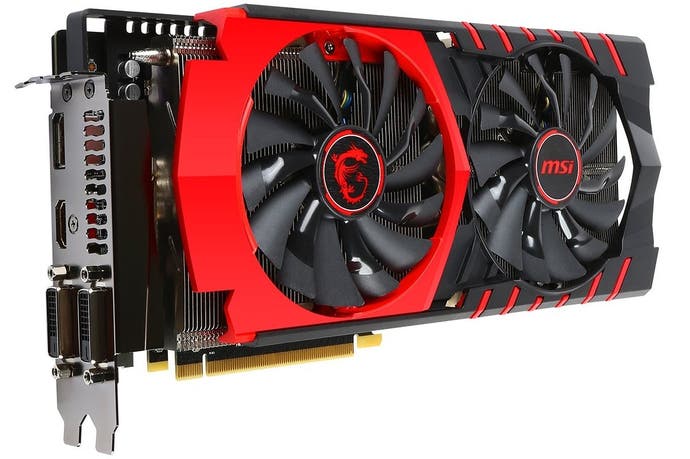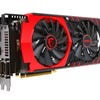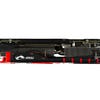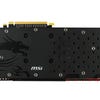Radeon R9 390X 8GB review
Too hot to handle?
On paper, the task facing AMD's engineers must have looked formidable. Having jostled for supremacy with Nvidia's GTX 780 Ti and Titan, the firm was clearly competitive with its Radeon R9 290X - until the arrival of GTX 970 and GTX 980, both of which outperformed the best that the red team had to offer, and did so with bags of overclocking headroom to spare. In producing the Radeon 300 series, AMD had to match or beat Nvidia's excellent performer - and not only that, it had to do it using existing silicon. We had doubts that it would be possible, but as the benchmarks rolled in, the bottom line became clear: AMD has done it.
It's a remarkable achievement bearing in mind that all the evidence points towards the R9 390X being little more than an overclocked version of the outgoing 290X. AMD dubs the 300 series version of the chip 'Grenada' but really and truly, a straight head-to-head strongly suggests it is the same as the existing Hawaii, simply with a 50MHz overclock - upped still further to 100MHz here in the MSI Gaming version of the card we're reviewing here. Now, there've been overclocked 290Xs before, but none of them have troubled the GTX 980 - something else must have changed to see the impressive performance we've looking at here.
That would appear to come down to memory bandwidth. The R9 390X features 6000MHz GDDR5, a 20 per cent improvement in terms of throughput over the 290X (and overclocked still further on this MSI board to 6100MHz) - the result of AMD shifting to a much faster, more capable Hynix memory module. And as a bonus, the firm has decided to double the allocation of VRAM up to a mammoth 8GB. Superfluous? Right now, yes. But in a market where many console ports now require 3GB to service 1080p, who knows what might happen in the months and years to come - especially when cards like the R9 390X are built to service more memory hungry resolutions much higher than the standard full HD?
Of course, there's just one problem here: heat. AMD's Hawaii chip is known for its prodigious power consumption and 'notable' thermals, a situation not helped by the firm kitting out press with overheating reference designs. But the reality is that add-in board manufacturers like MSI, Sapphire and Asus got a handle on Hawaii within months of release, their refined coolers drastically reducing core temperatures and completely removing performance throttling in the process.
The cooler design we have here on the MSI board is substantial to say the least, with a very meaty heatsink and dual fans - enough, the firm says, to displace 500W worth of heat. On our test bench, with the card exposed to the open air, temperatures never rose about 73 degrees Celsius. It's an impressive showing - enough for MSI to overclock the already overclocked design - but the fact remains that the power hungry chip is now even more thirsty for juice. The MSI cooler dissipates the heat, but it's got to go somewhere. The bottom line: ensure your case has great airflow.
- Order the Radeon R9 390X 8GB from Amazon with free shipping
In terms of physical appearance, aside from the somewhat outsize heatsink, it's pretty much business as usual for an MSI card. Decked out in the firm's trademark Gaming Series colours, it's a good-looking piece of kit and clearly very well built. Power is supplied via a standard six-pin/eight-pin PSU inputs, and ports come in the form of the standard HDMI 1.4a, DisplayPort and dual DVI video outputs. LEDs behind the MSI logo allow for some degree of customisation via a new MSI Gaming app, but we have now reached the point where the majority of aftermarket cooling designs out there do a great job in ensuring that performance throttling isn't really an issue, even with a chip as meaty as this one.
So, can an overclocked 290X with upgraded memory really take the fight to the GTX 980? Well, as you'll see in the benchmarks later on, it's clear that each card has its strengths and weaknesses - something we can address head-on as we dive into our first performance test, our standard Crysis 3 gameplay challenge. The idea here is that we want to run a truly demanding game at its highest settings, and we want to get the best experience by matching both resolution and frame-rate to the display. Usually, we opt for either 1080p or 1440p as our target resolution, but this time we went for both.
There's a reason for that. Locked to 60fps via v-sync, what immediately becomes clear is that both cards are clearly over-specced for 1080p - only a handful of frames are lost, but GTX 980 has the advantage. However, at 1440p, the situation reverses - neither card can lock at the desired 60fps (you'll need to drop down to the high setting to do this), but what's clear is that now the R9 390X is more competitive. It's slightly faster than its Nvidia equivalent. To cut a long story short: the more pixels you drive, the more AMD's prodigious memory bandwidth comes to the fore.
| Crysis 3 V-Sync Gameplay | R9 390X 1080p | GTX 980 1080p | R9 390X 1440p | GTX 980 1440p |
|---|---|---|---|---|
| Lowest Frame-Rate | 47.0fps | 51.0fps | 32.0fps | 31.0fps |
| Dropped Frames (from 18650 total) | 107 (0.57%) | 27 (0.14%) | 3270 (17.53%) | 3852 (20.66%) |
Order the graphics cards tested against the R9 390X from Amazon with free shipping:
Moving onto the benchmarks, we find ourselves facing a problem. Comparing against the GTX 980 is a no-brainer - it is the card that AMD targeted in defining the R9 390X's spec. However, the R9 290X is so much cheaper (while stocks last, of course) and it is built using the same core processor. It's the next obvious comparison point, but the problem is that AMD has forked its drivers - the 15.15 300-series driver won't work with the older card while the existing 15.5 200-series driver doesn't work on the 390X. This presents a problem as downclocking the 390X to match 290X, we noted some notable differences in performance: Assassin's Creed Unity, for example. The solution? A hacked 200-series compatible 15.15 driver showed no performance drops on our test titles with the 290X, and suddenly downclocked 390X performance was a match on our test subjects. We're going to assume that those optimisations will roll out to all AMD users in due course, and that's the like-for-like comparison we're going to go with for this piece. [UPDATE 10/7/15 6:51pm: This has now happened - Catalyst 15.7 brings 300 series software optimisations to 200 series cards like the 290X.]
And kicking off with the 1080p analysis, it looks like business as usual for Nvidia, beating the 390X on seven of our nine test titles - the outliers being the usual suspects: the AMD-friendly Shadow of Mordor and Ryse, both significantly faster than the GTX 980. Aside from Crysis 3 and Far Cry 4, which are only moderately faster on the Nvidia hardware, five titles are over 10 per cent swifter on GTX 980. Meanwhile, as expected, the R9 390X is clearly faster than its predecessor, averaging out at an 11.3 per cent speed bump, with only Call of Duty Advanced Warfare disappointing here. In our test sequence, the 390X is only 3.4 per cent faster - clearly the game isn't so reliant on memory bandwidth.
The takeaway here is that while the GTX 980 and R9 390X might be overkill for 1080p, full HD remains the most popular resolution when it comes to gaming displays. If you're looking for a very fast card for this pixel count, the GTX 980 remains the default choice - but let's not forget that the R9 390X is £50 cheaper, and that its wide memory interface shows progressively higher performance the higher the pixel-count you throw at it.
| 1920x1080 (1080p) | R9 390X | GTX 980 | R9 290X |
|---|---|---|---|
| The Witcher 3, Ultra, HairWorks Off, Custom AA | 57.4 | 65.8 | 50.5 |
| Battlefield 4, Ultra, 4x MSAA | 78.3 | 86.5 | 69.0 |
| Crysis 3, Very High, SMAA | 80.1 | 81.5 | 69.7 |
| Assassin's Creed Unity, Ultra High, FXAA | 56.0 | 62.4 | 50.0 |
| Far Cry 4, Ultra, SMAA | 82.4 | 87.4 | 75.0 |
| COD Advanced Warfare, Extra, FSMAA | 112.3 | 128.1 | 108.6 |
| Ryse: Son of Rome, High, SMAA | 81.8 | 76.1 | 74.5 |
| Shadow of Mordor, Ultra, High Textures, FXAA | 101.9 | 91.7 | 89.4 |
| Tomb Raider, Ultimate, FXAA | 107.1 | 118.2 | 97.9 |
GTX 980's dominance recedes at 1440p - the card still beats the new AMD offering handily on the Witcher 3, but its other wins probably won't impact the gameplay experience to the same degree - Assassin's Creed Unity, Battlefield 4 and Advanced Warfare are all less than four per cent faster in our tests, while a just a single frame separates the two cards on Tomb Raider. We are swiftly approaching the margin of error, and factoring in the R9 390X's cheaper price and its higher RAM allocation, the card is looking more enticing - especially as it outperforms the GTX 980 in several of our test titles.
The R9 390X has its own marginal win - Crysis 3 being 4.6 per cent faster - but the likes of Far Cry 4 and Shadow of Mordor are almost 13 per cent swifter, while Ryse has a significant 15 per cent advantage. The common denominator here with those three titles is their console heritage, and we know that with Ryse in particular, its compute-heavy engine design favours AMD hardware. It was optimised for the consoles' GCN hardware, and the PC equivalent benefits as a consequence.
Meanwhile, the higher pixel count also sees the differential with 290X rise too - we're up a couple of percentage points, with our MSI 390X averaging out as 13.4 per cent faster. A couple of points of interest here: Advanced Warfare continues to scale poorly (it's at just 6.8 per cent here), but on the flipside, the R9 390X is a whopping 20 per cent faster on Far Cry 4 in our test sequence. Clearly it thrives on memory bandwidth.
| 2560x1440 | R9 390X | GTX 980 | R9 290X |
|---|---|---|---|
| The Witcher 3, Ultra, HairWorks Off, Custom AA | 43.5 | 47.5 | 38.2 |
| Battlefield 4, Ultra, 4x MSAA | 54.5 | 57.0 | 47.2 |
| Crysis 3, Very High, SMAA | 52.3 | 50.0 | 44.8 |
| Assassin's Creed Unity, Ultra High, FXAA | 38.4 | 39.7 | 34.4 |
| Far Cry 4, Ultra, SMAA | 69.0 | 61.3 | 57.5 |
| COD Advanced Warfare, Extra, FSMAA | 94.7 | 98.2 | 88.7 |
| Ryse: Son of Rome, High, SMAA | 62.2 | 54.1 | 55.9 |
| Shadow of Mordor, Ultra, High Textures, FXAA | 74.4 | 66.0 | 65.9 |
| Tomb Raider, Ultimate, FXAA | 75.7 | 76.7 | 67.2 |
With our 4K testing, we acknowledge that running at max settings is going to be a recipe for disaster - and to be frank, it still is, even if you're running a Titan X - so we opt instead to knock down settings to a more reasonable level, usually just one 'notch' down from the max. In the case of all titles - except Assassin's Creed Unity and The Witcher 3 - this keeps our frame-rate averages above the 30fps that we consider essential for playable action. Not surprisingly, ramping up resolution still further brings the advantages of the 390X to the fore.
Nvidia's GTX 980 has just one win here - Battlefield 4 is around five per cent faster, but otherwise it's a clean sweep for the R9 390X. Titles like The Witcher 3, Crysis 3 and Advanced Warfare aren't that much faster, but AMD mainstays Ryse, Shadow of Mordor and Far Cry 4 open up an even more commanding lead over GTX 980 than they did at 1440p. They're anything between 18 to 23 per cent faster, and that's highly significant at this resolution. Meanwhile, the aggregate advantage over the older 290X is still in the 13 to 14 per cent range.
The question is, can the R9 390X really be considered capable enough for 4K gameplay? Our take on it is that the new uber-cards - GTX 980 Ti, Titan X and Radeon Fury X - are still the minimum 'go to' hardware for that kind of sheer pixel density. At the 390X and GTX 980 level, you're going to need to pick and choose your battles - some games can work very nicely, but we consider 60fps gameplay the sweet spot, and we suspect that it'll require cutting down on a lot of quality presets to get some titles to that standard. Clearly, not every game is as well optimised and as '4K ready' as Call of Duty Advanced Warfare.
| 3840x2160 (4K) | R9 390X | GTX 980 | R9 290X |
|---|---|---|---|
| The Witcher 3, High, HairWorks Off, Custom AA | 29.1 | 27.7 | 26.1 |
| Battlefield 4, High, Post-AA | 44.5 | 46.8 | 39.6 |
| Crysis 3, High, SMAA | 40.2 | 39.0 | 36.1 |
| Assassin's Creed Unity, Very High, FXAA | 22.7 | 21.8 | 18.7 |
| Far Cry 4, Very High, SMAA | 44.4 | 36.1 | 37.4 |
| COD Advanced Warfare, Console Settings, FXAA | 76.4 | 72.0 | 67.5 |
| Ryse: Son of Rome, Normal, SMAA | 37.8 | 31.5 | 34.0 |
| Shadow of Mordor, High, High Textures, FXAA | 50.1 | 42.4 | 44.8 |
| Tomb Raider, Ultra, FXAA | 51.4 | 47.1 | 45.9 |
There's a few points we need to address here before we move on. Firstly, MSI's card is not a reference-standard 390X. It's been overclocked, but not to a ridiculous degree - less than five per cent to the core and around 1.5 per cent on the RAM. It'll make a difference, but it won't be massively pronounced (overclocking rarely scales in a linear manner in terms of actual performance) and we'd venture to suggest that any 390X on the market could match those clocks with no real effort - all of them seem to come with substantial cooling solutions. Secondly, the GTX 980 we've benched here is a reference model, and there's very few of those on the market. Most GTX 980s should have some kind of minor factory overclock in effect - our Titan X review, which includes an MSI factory overclocked GTX 980 (that unfortunately we don't have access to any more) gives you some idea of what the boost a factory OC gives you.
Secondly, you might note the lack of overclocking benchmarks here. Part of this is down to timescales (we have a Fury X review we need to be getting on with) but equally, based on initial testing, we can't really recommend overclocking this card much further than MSI has already taken it. The card ships at 1100MHz and anything beyond 1160MHz on the core causes on-screen artefacting, and the already prodigious power consumption increases still further - on our system, it hit a mammoth 540W during Crysis 3. Even in its factory state, our system managed a peak 499W power draw when combined with our overclocked i7 (our tests below were carried out with the i7 set back to its stock configuration).
The processing capabilities of this card, combined with its 8GB framebuffer may make it sound like a good contender for CrossFire 4K gaming, but the power draw and heat generation from two of these behemoths is going to be immense. Secondly, from a financial perspective, the existing Radeon 295X2 with its supplied closed loop water cooler just makes more sense - even if it will take a performance hit from its slower RAM. The bottom line here is that running two overclocked Hawaii chips in one system really does require some kind of water-cooling solution, and in the 295X2, there's a robust, ready-made solution that costs much, much less than two R9 390Xs.

| R9 390X | R9 290X | GTX 980 | |
|---|---|---|---|
| Peak System Power Draw | 477W | 400W | 294W |
Radeon R9 390X 8GB: the Digital Foundry verdict
The case for the Radeon R9 390X is crystal clear: it's significantly cheaper than the GTX 980, it has twice the amount of on-board GDDR5, and following the upclock and RAM revision, it is comparable from a performance perspective - as long as you're not a 1080p gamer, where the GTX 980 clearly remains the best choice. However, if your display operates at 1440p or an even higher resolution, the performance credentials of the card bring it into line with the competition, surpassing the GTX 980 in several of our test games.
The case against is equally clear: there's little overclocking headroom left, and the 390X's power consumption is quite staggering. But let's be clear: a power-hungry card doesn't necessarily mean it's a nuisance from a noise perspective: in fact, MSI's cooler here is quite remarkable in terms of both it lack of noise and thermal dissipation. However, the fact remains that a lot of heat is being pumped into your case and you'll need to ensure that your chassis is capable of expelling it effectively - and the room will definitely get noticeably warmer as a consequence! Additionally, we find the 390X hard to recommend for multi-GPU scenarios, whereas Nvidia's GTX 970 and 980 both perform well here thanks to their enviable power efficiency, plus better driver support.
Overall, there's perhaps a sense that AMD has dragged the 290X kicking and screaming into a performance envelope comparable with GTX 980 but in the final analysis, there's no denying that AMD has achieved what it set out to do: R9 390X offers a gameplay experience similar to its Nvidia counterpart, though the decent overclocking of the GTX 980 may well give the green team final bragging rights.
But it's the practical value of the R9 390X's 8GB of GDDR5 that remains something of a mystery. Actual use-case scenarios beyond 4GB are limited right now, and the decision to kit out 390X with twice the memory of the new Fury X flagship is curious to say the least. But what's clear is that games' appetite for VRAM is only going to move in one direction, and as developers have been telling us for years now, the more GPU memory you have, the better - and in R9 390X, it's kind of reassuring just to know that it's there.










